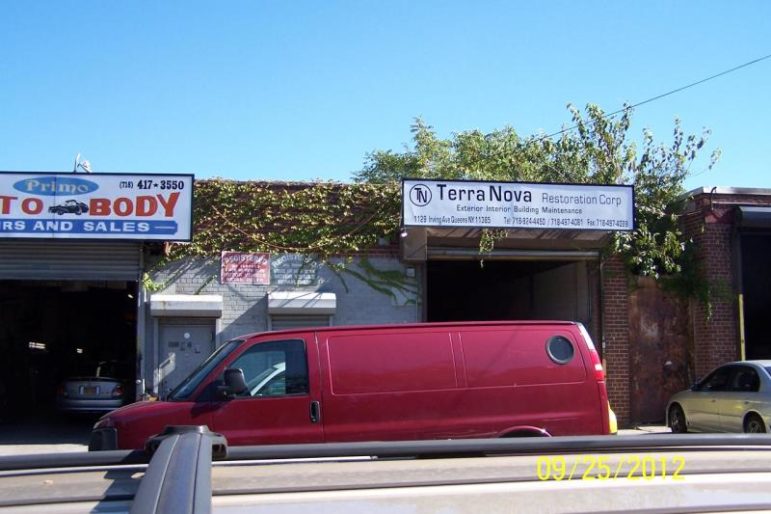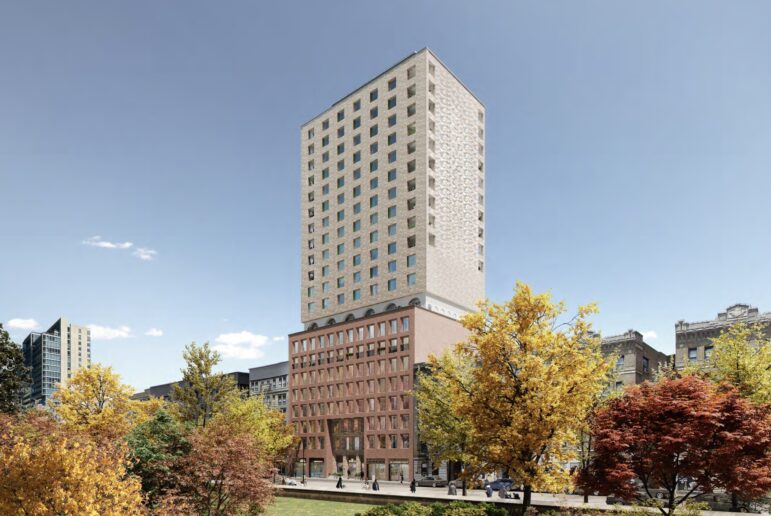
EPA
The EPA says it will issue a proposed cleanup plan, request public comments and host a public meeting about the Wolff-Alport site later this year.
Before the U.S. Atomic Energy Commission started buying thorium byproduct from the Wolff-Alport Chemical Co. in Queens to make nuclear bombs, the chemical company thought it was worthless and dumped the radioactive sludge into the sewer or buried it under its triangular property on the border between Bushwick and Ridgewood. Now the site hosts Los Primos Auto Repair. And the Jarabacoa Deli.
The unassuming single-story row of businesses at the end of Irving Avenuehas been dubbed “The Most Radioactive Place in New York,” by The New Yorker — and if the Trump administration’s proposed cut to the federal Superfund program goes through, it may not lose that nickname for quite a while.
Wolff-Alport is one of three federally designated Superfund sites in New York City, but unlike the other two that garner more attention — Gowanus and Newtown Creek — the U.S. Environmental Protection Agency (EPA) has yet to find a responsible party who can pay for this cleanup. If no responsible party is found, Wolff-Alport will be designated a so-called “orphan site,” and the EPA will need to dip into its Superfund trust to pay for the cleanup. But that Superfund trust — which a former EPA official told City Limits is already too small to do a growing amount of cleanup work nationwide — is on Trump’s chopping block. Trump’s 2018 budget blueprint proposes cutting the Superfund trust by 30 percent, or $330 million.
Judith Enck, who served for seven years as director of the EPA’s Region 2 until earlier this year, says if these cuts go through, work at Gowanus and Newtown Creek may slow down, but an orphan like Wolff-Alport may get neglected for years.
“I’m concerned about this,” says Enck. “It’s in a very heavily populated urban area that is not your classic Superfund site that’s an isolated farm field with a chain link fence around it that no one goes near.”
The danger is real. Wolff-Alport’s preliminary contamination score, which determined it was eligible for Superfund status, was the same as Gowanus and Newtown Creek. At one point, Enck says a health report determined that people shouldn’t walk along the sidewalk near the building — and that nobody should lie on their back near the site. But the City of New York refused to close the sidewalk and the auto body workers simply couldn’t do their job without lying on their backs under cars.
“I was astonished at what I found and appalled that so much time went by that any regulatory agency did anything about it,” Enck says.
In 2012, two years before Wolff-Alport was even designated a Superfund site, the EPA installed a shield to significantly minimize the potential exposure to radiation for the auto shop workers and people passing by on the sidewalk. But that was just the beginning. The contaminated site will likely need a massive cleanup that will cost in the hundreds of millions of dollars.
“It’s important that this cleanup get started and not languish for years and I’m really nervous that if the Trump administration goes through with these cuts, Wolff-Alport will indeed languish longer than it already has.”
Radioactive history in Ridgewood
On a recent afternoon, 99 years after a chemical engineer named Harry Wolff started producing rare-earth metals on the corner of Irving Avenue and Cooper Street, P.S. /I.S. 384 Frances E. Carter let out. The school is located two long blocks away from the former chemical plant, just across the Queens line in Bushwick, Brooklyn. Some kids stop in the Jarabacoa Deli, located next to Los Primos Auto Repair, to buy sodas.
The area hasn’t shed its industrial past. Mechanics work on a dozen or so cars inside and outside the auto body shop. The owner of Los Primos, Alberto Rodriguez, kneels by a broke-down Chevy van on the sidewalk in front of his shop. In the past, Rodriguez has complained that the work at the site disrupted his business. When asked this week what he’d like to see done at the site now, he shakes his head.
“They’re supposed to clean it up,” Rodriguez says. “They put in the metal here, but nothing official. The contamination stayed there.”
Rodriguez was referring to the concrete, steel and lead shield the EPA installed in 2012 to minimize the risk to him and his workers. Currently, the EPA is not actively working at the site.
While continuing to look for potential responsible parties [PRPs], the agency is preparing a feasibility study, which is expected to be released this summer.
“Currently, the EPA is completing its study of the nature and extent of contamination. This step is known as a ‘remedial investigation/feasibility study,’ which looks at the nature and extent of contamination and evaluates potential cleanup options,” EPA Public Information Officer Elias Rodriguez wrote in an email.
Later this year, according to Rodriguez, the EPA will issue a proposed cleanup plan, request public comments and host a public meeting.
Ridgewood has already benefited from the Superfund trust that Trump wants to cut. So far, the EPA has spent $3.5 million on the Wolff-Alport site, which in addition to the underground shield includes fencing.
Superfund on fumes
When the Superfund program was created in 1980 — under the Comprehensive Environmental Response, Compensation, and Liability Act (CERCLA) — its motto was “polluters pay.” The legislation gave the federal government the power to make polluters pay for cleaning up and restoring toxic sites. The law also taxed chemical and petroleum companies and put those funds into a Superfund trust to ensure that orphan sites would also get cleaned up.
Congress let the tax expire in 1995 under pressure from the chemical and oil industries and the fund decreased in the years following. In 2002, when it needed more funding, George W. Bush did not reauthorize the taxes on corporations and instead shifted the burden to taxpayers. Since then, most of the funding for the Superfund trust comes from the general fund. So the trust, valued at $3.8 billion in 1996, according to The New York Times, decreased significantly to its $1.1 billion last year.
“Even when I was at EPA, Superfund was running on fumes, so this is very, very serious for that site [Wolff-Alport],” says Enck.
As the funding has dropped, the work has increased. The 1980 law mandates that every site be reviewed every five years, so even after the EPA cleans up a site, they have to check back in on it forever.
EPA staff even struggle to keep up with the sites that have funding from polluters, like Gowanus and Newtown Creek. Sean Dixon, a staff attorney at Riverkeeper who sits on the Gowanus Canal Superfund Community Advisory Group, says it’s hard for the EPA to compete with the polluters.
“Even at the functional sites, they are burdened by the fact that these PRPs [potentially responsible parties] have billions of dollars, teams of lawyers, teams of their own scientists,” Dixon says. “Gumming up the work is a way that every PRP can try to delay having to spend $100 million on cleanup. We’re already behind the ball on those sites.”
Trump’s so-called “skinny budget” calls for a 31 percent, or $2.4 billion, cut to the EPA. But recently Congress approved an omnibus spending bill that continues funding the EPA at a relatively normal level through the remainder of this fiscal year. So the proposed cut will affect next year and will be decided by Congress in September. The massive 31 percent cut may mean the EPA is forced to close two of its 10 regional offices, which is what the Trump administration reportedly wants. It’s unclear what offices would close, but Enck says if Region 2 were to close, it’d be bad for cleaning up contaminated sites.
“Region 2 is very vulnerable because Region 2 has a lot of superfund sites. The state of New Jersey has the most superfund sites in the nation,” says Enck.
Currently, there are 1,337 sites on the federal National Priorities List, which the EPA uses to determine what sites need to be cleaned up with its Superfund program. There are also 53 proposed sites.
Wolff-Alport sat untouched for decades in Queens before the EPA designated it a Superfund site in 2014, so there could be other unknown sites. Dixon says he’s worried that the cuts would mean sites that should get Superfund status will not be added to the list, including Coney Island Creek.
“If you look at the rest of New Jersey, they have a lot of Superfund sites, and if you look at New York City, we have three. It doesn’t make sense,” Dixon says. “It worries me that we only have three sites.”








One thought on “Next100: Cleaning Up the City’s Most Radioactive Block Threatened by Trump’s EPA Cuts”
I have no credentials to weigh or balance or compare the magnitude of the radioactive waste at the site about which you report, but also within NYC, Great Kills Park on Staten Island has a similar problem:
http://whowhatwhy.org/2015/06/30/last-secret-of-the-atom-bomb/
and
https://www.nps.gov/gate/learn/management/greatkillscleanup.htm
I’m trotting this out not to hijack your story but to suggest that making common cause with a borough (Staten Island) that voted for Trump at a higher percentage rate than Texas might lead to progress on the issue of radioactive waste in NYC. (I’m not holding my breath….)